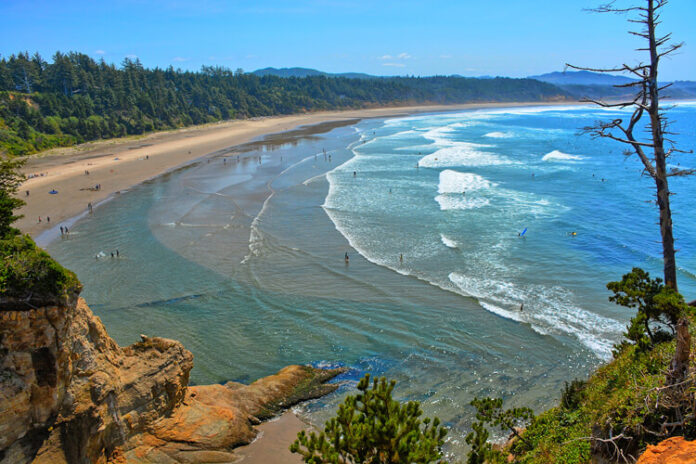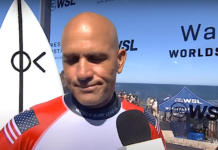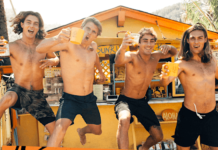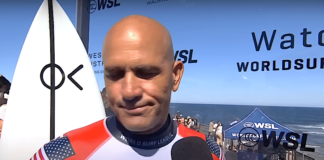It’s 45 °F, and I am at 45 degrees North, 70 miles east of the coast.
Daylight breaks before the sun is fully up. After coffee and oatmeal, I head down three stories to the garage to put the roof rack on the car.
In Honolulu, Hawaii, I walk the board to the beach as the sun gently rises behind Diamond Head. In SoCal, the board always fits in the rental car.
This new ritual begins my day as I now surf in the cool water of the Oregon Coast.
Growing up in Portland, I spent a lot of time on the Northern Oregon Coast.
As a teenager, my father, a chief bosun’s mate on merchant ships in World War II, took me fishing from Hammond out of the mouth of the Columbia River, the graveyard of the Pacific.
He taught me small craft seamanship and that our actions are controlled by weather and the tides.
My job was to man the helm, stay on the compass heading, and be alert. Watching the swell all day long, I was building waterman skills, even if I was not surfing.
The Columbia River is the fourth largest in the United States, the greatest outflow of any river into the Pacific Ocean, and the 36th greatest in the world.
Sought out by the great explorers as a possible Northwest Passage (NWP), only modern engineering has made it passable.
Often foggy, there is Peacock Spit to the north, where the WNW swell builds and breaks onto a jetty.
A wide beach to the south masks the river opening; it’s a great place to go around in a storm. At ebb, the river can flow at six knots.
In the channel at a very low tide, it is easy for a ship to bounce along the bottom amid breaking waves.

A Cold and Wave-Rich Coast
Much of the Oregon Coast is a shallow beach break created by the sand deposited from the Columbia and the numerous coastal rivers.
Year-round, the water is cold to the touch.
A casual observer sees one breaking closeout wave followed by five additional rows of junky shore break.
Dangerous to beachcombers, the foam has a strong push, and the flow back is just as strong with the direction often parallel to the beach, as all that water seeks a channel in the ever-shifting sand bars.
Standing in the shallow in a wetsuit, waiting for relative calm to paddle out, you experience the strong pull.
You can also imagine the fight to find the bottom and your way in the frigid water wearing street clothes, boots, and a coat, heavily soaked.
Several people every year are knocked down, drug out, and drown.
At 68 years old, with one arm and used to the mellow swell of San Onofre and Dana Point in Southern California and the South Shore of Oahu, I fasten my log to the rack for the commute to the coast.
I’m stoked to be on the water, dreading the pummeling and wondering how I will handle the cold.

Shorty’s: A Secluded Sanctuary
The Oswald West State Park parking lot leads to Shorty’s, aka Short Sands, or Smugglers Cove on the surf report.
We’re close to the 4th of July, and I feel like I am in a winter surf clothing ad with warm clothing, a hat, a backpack, and carrying my board through the forest trail of Douglas fir, hemlock, and cedar.
A little over 400 meters, the trail opens onto a beach shielded on the north and south by large headlands.
As Oregon’s most popular surfing spot, it is often crowded but shielded from the stiff NW winds which bring summer weather to the rest of the state.
The protection – it this or nothing. Forty or so surfers are strung out along the length of the beach.
There is a range of waves and plenty of room to find a spot to hunt something easy.
After an hour, I manage to snag a few slow, mushy rights. I am not cold, not beat up, and have had a great time. This just might work.

Pacific City: A Longboarder’s Heaven
Forty-five minutes to the south is the certified census-designated Pacific City/Cape Kiwanda, home to beach-launched dory boats and the longboarding capital of Oregon.
A sandstone headland and a monolith called Haystack Rock block the NW wind of summer but still allow a long period swell to put the thoughts of epic long rides into the head of a longboarder.
The first time I saw it, it looked like my new home.
You park right in front of the beach and make a short walk down a sandy slope to the water’s edge.
The surprise is either an easy paddle out or a fight.
A friend’s son, who has surfed the Oregon coast for 25 years, told me a three-foot swell here had given him the worst beatdown in his life.
Last fall, in 60 °F (15 °C) water, I had a couple of fun easy days catching both lefts and rights.
This year, it’s 4-to-5 feet with an eight-second period.
I get up a couple of times, leaving the water tired but exhilarated. The adrenalin stays in my body the rest of the day.
It’s now four o’clock in the afternoon.
I parked on my beach at the top of the sandhill behind the rental house, watching the surf, and I can still sense being in the water, doing my best to pop up super quick, and wanting to face the challenge again.
After a day of rest and calmer conditions, I easily paddle out and enjoy the wait for the small swell to deliver a nugget.
As the wind builds, I paddle north, wait for a wave, paddle north, wait for a wave. Thirty minutes later, I am 200 meters south of where I entered.
Deciding to be practical instead of stupid, I ride a foamy in and just walk north on the beach.
I’ve seen better days, but I’m stoked and begin to feel comfortable in less than the ideal conditions I have milked for a few years.

The Cove: The Ultimate Test
From my house, it is only one stop sign, a traffic light, 70 miles of road, and one more traffic light between The Cove and me.
Reading that The Cove in Seaside, Oregon, had a reputation as a fiercely defended, “locals-only” spot, I look for a guide for the summer. I find Lauren Ahlgren of Seaside/Arch Cape and owner of Oregon Surf adventures.
I knew I had a shot at riding the small, long, and slow left The Cove is known and rumored to produce.
Lauren played water polo and pole vaulted.
She is strong in the water, fearless, and a positive attitude that can turn a crappy weather day into your best day of the week.
Working a lot with kids, she easily shares her knowledge of each break, what tides work, how the sand bars form, relevant minutia, and an occasional story.
For example, during summer, every Tuesday, she hosts a “Lady Logger” night at Shorty’s.
Butting up against the north base of Tillamook Head is The Cove.
Easily blown out with the summer NW winds, as fall approaches and the wind comes from the south, the magic starts to emerge.
At first, it is a delicate small swell that requires a pop-up on your front foot to grab as much speed as possible.
A month later, there is enough force to create a nice lift and a more leisurely take-off.
The best days are when the long left appears, aided by a conveyor belt channel that pulls you out along the rocky shore of the Head back out to the lineup.
Late fall and into the winter, 10-to-18-foot waves at 18-20 seconds turn it into a big wave paradise.
Pure envy, when I hear someone I know with the skill and youth to enjoy it that way.
This is also the time when the locals get a little testy, but for a good reason. The spot now becomes farther out on the Point.
The policing is based a lot on safety. It is big boys and girls surfing. They need to know you are good enough to belong.

Final Reflections
Did I turn into an Oregon surfer, or am I just someone who lives in Oregon that surfs? It was great to have almost a five-month season.
My wife, Carie, became a first-class surf tech.
She drove the car, analyzed the waves, pulled on my 4/3 mm wettie, booties, hood, and found my glove.
By September, it was a smooth trip. I don’t think I went over two weeks without being in the water.
Checking the surf report daily, we tried to make plans for week-long stays, sometimes in vain. Ironically, it was small wave alert surfing.
The gear bag ready to travel on short notice. My year-round training sessions have a sharp focus and are always ready to go.
The dream is still to live for an extended time at the beach, somewhere.
With chores and family life, a six-hour trip is a day.
There is no way to sneak in a short morning session before the wind comes up or catch an early evening south swell.
More remote work will make it easier for some people, but travel will not be the same till late into next year, and I do not have much time left.
Life right now is lived from one four-month cancer check to the next, but Oregon did give me a very long summer.
I was stretched and challenged – every session was a thrill and an adventure.
Words by Steve Brown





